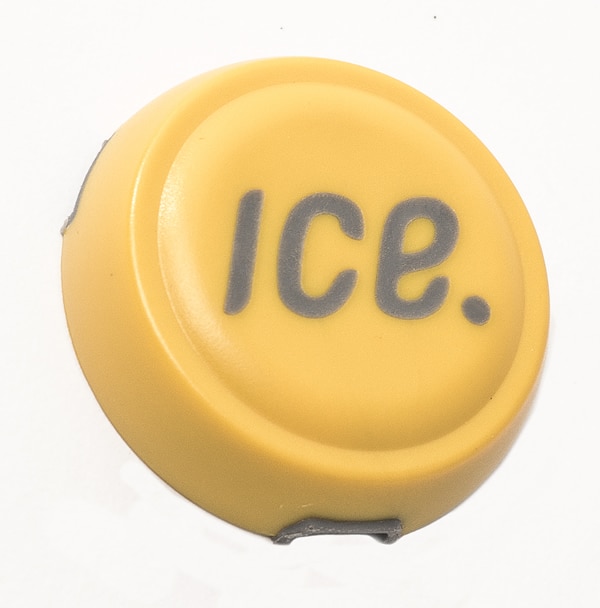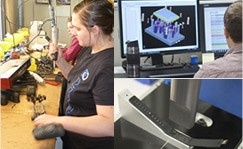Secondary Operations
Finishing, Assembly, Packaging & More
Many injection molded components require additional secondary operations, whether for cosmetic enhancement, branding, assembly, or integration, and oftentimes are kitted and shipped in retail packaging. As a turnkey manufacturing partner, PILLER AIMMCO offers a wide range of assembly and integration options, both in-house and via managed outsourcing.
In-house capabilities include:
- Ultrasonic welding (USW)
- Corona treating
- Mechanical assembly
- Secondary machining
- Kitting
- Retail & custom packaging
- Hot stamping
Managed outsourced services include:
- Pad printing
- Laser engraving
- Color ink jet printing
- Hot stamping
- Custom labeling
- Vacuum metalizing
- EMI shielding
- Liquid painting & coatings
- Hydro-graphics (water transfer ink printing)
- Silk screen printing
- Engraving
Whether your needs involve simple branding or full turnkey part-to-box assembly, we have the equipment, experience, and expert staff to achieve results. Contact PILLER AIMMCO to discuss your requirements.
Secondary Operations for Low & High Volume Production
Branding & Cosmetic Part Enhancement
Cosmetic part enhancement and branding can involve any number of steps and processes, depending on the cost objectives, functionality, and aesthetics of the parts involved. In many instances, branding can be accomplished most cost effectively with raised or recesses features in the part itself, or by contrasting two or more materials in the same part using a multi-shot molding process. In all cases, it is important to consider the cosmetic and branding needs early in the design phase in order to make informed decisions regarding materials and features, and avoid unnecessary delays and additional costs.

Cooling Fixture
Pad Printing
Pad printing is an ink transfer process that is commonly used to produce logos or demarcations in single or multiple colors. This process requires a fixture to accurately locate the part being printed, as well as a dedicated transfer pad. Care must be taken to select inks that are compatible with the plastics being printed and to ensure they will provide the necessary wear and environmental resistance. Pad printing is a highly repeatable process capable of producing intricate designs and patterns, and is suitable for both low and high volume production. This is a cost effective process, particularly if automation such as rotary or shuttle tables can be employed at higher production volumes.
Laser Engraving
Laser engraving on plastic components is another common way to provide demarcations such as serialization, part numbering, UL/CE marks, etc. Some thermoplastic resins will produce acceptable laser marks without any further enhancements, but due to the wide variations in thermoplastic compositions and the variations in laser marking equipment (power, wavelength, laser type), it is often necessary to custom-formulate a thermoplastic resin with additives that will yield predictable results with the specific laser equipment being used.
Vacuum Metalizing
Vacuum metalizing or physical vapor deposition (PVD) is commonly used to produce decorative and functional metallic finishes on plastic substrates. It is a batch process, with parts placed in a chamber under high vacuum. The metalizing medium is either heated until it evaporates and condenses on the substrates, or impacts the plastic substrate via a sputtering process. Very precise thicknesses are possible depending the process, equipment, and controls. Typical applications include chrome-like decorations, reflective and light transmission coatings, and EMI/RFI coatings.
Liquid Painting
Injection moldings can be finished with a multitude of liquid paints, although the associated costs typically limit this finishing option to highly cosmetic applications where a finish beyond the quality of an as-molded part is desired. The effects possible with liquid painting (such as color, gloss, and surface quality) are generally not possible with other finishing methods, so liquid painting is widely used for highly cosmetic injection molded thermoplastic components.
Aside from cost, when considering liquid paint for a particular application, care must be taken to ensure the plastic substrates are suitable in terms of adhesion. Thermoplastics differ in their surface energy, which effects the strength of the chemical bond that can be achieved. Depending on the composition of the plastic, pre-treatments might be necessary (such as corona or flame treating) to enhance the surface energy, and in most instances, primers are needed prior to top-coating. Although generally not an inexpensive option, liquid painting does fill a unique cosmetic niche, achieving colors, effects, and surface qualities not obtainable with other processes.
Water Transfer Ink Printing (Hydrographics)
Water transfer ink printing (also referred to as “hydrographics” or “immersion printing”) is a batch process where graphics are applied to a part through a dipping process. A water-soluble graphic ink film is placed on the surface of an open water container. As the part is dipped into the container, the ink layer suspended on the surface adheres, wrapping around external features of the part. The part is then removed and dried, and if required, coated with a clear protective finish.
Unique effects can be achieved with water transfer printing with single or multiple colors, such as camouflage, carbon fiber, and wood grain patterns. When automated, costs for this process can be quite inexpensive, while batch manual processes will naturally be more expensive. In either case, water transfer ink printing is typically the least expensive method to produce certain patterned effects. However, there is typically an inherent degree of variation in the registration of the image on the part, so the process is generally not suitable when precise location is required.
Hot Stamping
Hot stamping is a lithography process involving dry inks or foils transferred at high temperature when placed between the part and a heated die. Artwork is printed on a roll leaf carrier that consists of multiple layers to provide adherence, color, and release. High levels of detail are possible based on the intricacy of the dies, including fitting curved or irregular shaped parts. Upfront costs for hot stamp tooling are typically higher than for pad printing, while cycle times are similar. However, the hot stamping process can produce metallic effects and multi-colored artwork in “one hit”.
Joining
Injection molded components typically require some form of mechanical joining to form sub-assemblies or to achieve desired component geometry. When possible, the least expensive approach is to incorporate mechanical locking features such as snap-fits for mating components. However, depending on geometry and strength requirements, threaded fasteners, bonded, or sonic welded joining methods may be requires. There are a number of design guides available from material and equipment suppliers that will assist the engineer in selecting the most appropriate joining method as well as in incorporating these features.
Threaded Fasteners
Threaded fasteners are routinely used for joining adjacent components. For low stress applications that do not require repeated assembly, threaded fasteners can be screwed directly into a boss feature of the plastic component. Care must be taken to size the boss feature appropriately to the fastener, and the proper plastic should be specified to ensure the hoop stresses inherent with this type of connection do not exceed that of the plastic and cause failure.
When higher mechanical integrity is required, or if the joint will be disassembled multiple times, brass, steel, or stainless steel threaded inserts can be molded into the component, ultrasonically installed after molding, or heat inserted after molding. In either case, the design of the boss will need to be considered according to the insert being used.
Ultrasonic Welding
Sonic welding, or ultrasonic welding (USW), is a very common and efficient process for joining plastic components. The resulting joint can be made liquid- and gas-tight, with strengths exceeding that of the parent materials. The process involves transmitting high frequency (20 – 40 kHz) vibrations into opposing parts, one nested in a fixture and the other contacted by the specially tuned “horn” of the sonic welding instrument. Then energy is concentrated at the interface of the opposing parts, causing the plastic to melt and thereby fusing the two parts together. Cycle times for ultrasonic welding are quite low, making it very cost effective, particularly when additional automation such as shuttle tables are employed.
While simple in principle, there are a number of variables inherent in the USW process that must be considered, and parts must be designed accordingly.
Thermal Heat Staking
Heat staking is an assembly method that involves the controlled melting of a feature in the plastic part that protrudes above the piece to be joined. Effectively, a rivet feature is molded into the plastic component, with the “head” formed during assembly by the heated tip of the heat staking machine. Thermal heat staking is commonly used for joining dissimilar plastics, and for joining plastics to other materials such as sheet metals, composites, PCBs, or fabrics. It is a low cost and reliable joining technique, with the opportunity to customize the stake head design, thereby influencing strength, appearance, and cycle time.
View this handy thermal staking design guide to learn more about the process.
Assembly
PILLER AIMMCO offers a range of in-house assembly services to assist clients in streamlining their operations:
- Full mechanical assembly
- Functional testing
- Electrical integration
- Supply chain management/sourcing of hardware & ancillary components
- Inventory management
- Engineering & documentation
Assembly work is carried out by our dedicated team of technicians, with full support from our manufacturing engineering team. Detailed work instructions and process documentation are prepared for each assembly sequence, including training requirements, critical quality checks, and functional testing. Automation is applied where appropriate, based on production volumes and cost objectives.
Packaging
Finished goods are always packaged to meet the needs of our clients. Whether that means bulk shipments using standard corrugated containers, custom thermoformed reusable trays and fixtures, or finished goods packaged in custom retail containers, our packaging is designed to ensure products arrive undamaged while meeting the cost and environmental objectives of our valued clients.
PILLER AIMMCO – We Plan, We Execute, We Deliver
Contact us today to discuss secondary operations for your injection molded parts and components.
